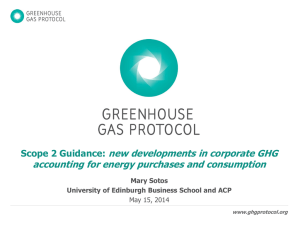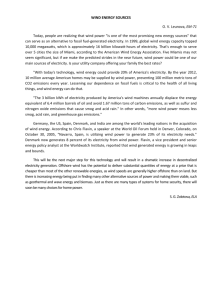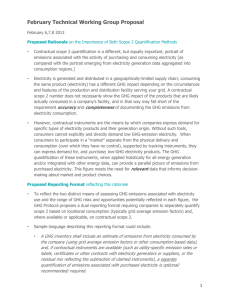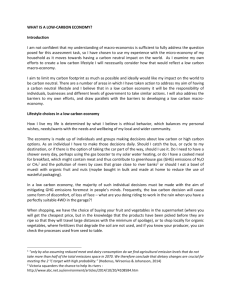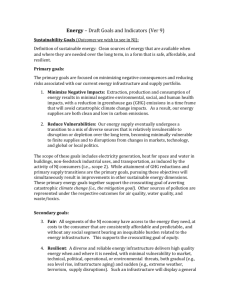Past, Present, and Future of the GHG Protocol
advertisement
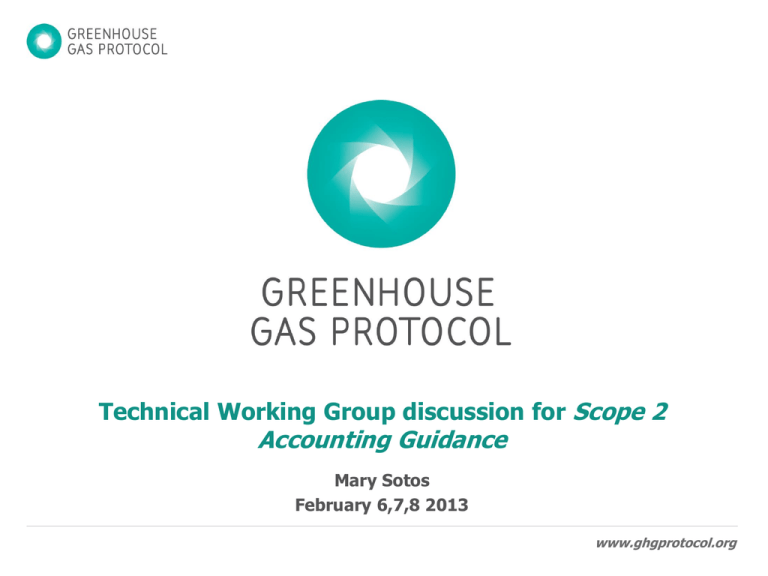
Technical Working Group discussion for Scope 2 Accounting Guidance Mary Sotos February 6,7,8 2013 www.ghgprotocol.org Today’s Agenda • Summary of prior TWG discussion (10 min) – Summarize December feedback • Proposed definitions and rationale (15 min) – Provide refined definition of “electricity as product” – Provide GHG Protocol rationale for quantifying emissions from electricity • Proposed reporting option (15 min) – Present reporting options that follow from definition and rationale • TWG Discussion (45 min) – Feedback on proposed definitions, reporting options, next steps • Next Steps (5 min) – Identify major next steps and areas for feedback www.ghgprotocol.org Summary of prior TWG discussion www.ghgprotocol.org Decision-making Define electricity as a product and its production boundaries Determine whether and where it can be a differentiated product Scope 3 framing Determine the implications and conditions for this treatment Operational element (no double counting, Drafting Write draft explaining accounting procedures, conditions and rationale How affect “reduction” tracking in scope 2? Additionality and eligibility? www.ghgprotocol.org Bigger picture journey Timing TWG phases of inquiry Final Guidance Identify current practices and issues associated with contractual quantification Appendix of instruments Categorize contractual instrument issues (attributes, ownership, eligibility) and draft text of potential treatment Operational Criteria Summer 2012 Re-assess underlying assumptions about contractual quantification, compare to grid average quantification in terms of 5 GHG Protocol principles, identify reporting options Description of method and GHG Protocol principles Dec 2012 Articulate indirect corporate accounting principles regarding “reductions” and the role of eligibility/additionality Appendix on eligibility features Frame two quantification methods in “product” terms to identify the product, and activity, being quantified Description of method and rationale Dec 2010May 2011 Summer 2011 – Spring 2012 Feb 2013 www.ghgprotocol.org December webinar questions #1.Electricity may be a product that can be “differentiated” within a grid system on the basis of contractual relationships, for accounting purposes. Is the logic presented here sound? #2. The allocation criteria and examples from scope 3 should be a basis for determining where and how this allocation can be operationalized for accounting purposes. Which apply, and what is the degree of GHGP stringency? #3. These Guidelines can support recognition for activities that, in aggregate, change global GHG emissions through several means. Which of these recommendations applies? www.ghgprotocol.org Additional TWG feedback (1 of 3) Electricity grid system diagram Yes it can be differentiated. Instruments decouple attributes from physical delivery, and attributes allow consumers to choose purchased electricity on the basis of environmental preference – treat like purchase of any other product - Electricity is different than other products - need to keep sight of link between consuming an actual product and the resulting emissions. Decision to buy attributes does not necessarily influence amount generated, as we assume with other products - Electricity is actually a uniform product, closer to first model presented - Is the contractual method a form of allocation, or avoiding allocation? - Will this analogy address heat/steam? - Allocation analogy impractical if it’s being executed by a single company – better done by grid admin or regional/national government - Language about liberalization of the electricity market not correct, liberalization is more about competition of “middle” actors rather than between generator and consumer www.ghgprotocol.org Additional TWG feedback (2 of 3) Operational criteria for allocation (based on scope 3) Overall helpful, but shouldn’t be too prescriptive given the imperfect analogy - Hierarchy of method should be based on reporting entity’s options, not the location - Physical delivery depends on electricity scheduling, availability of transmission capacity– all factors that shouldn't constrain transfer of generation attributes or usage claims - Boundary should be based on consistency in the regulator framework - International or transoceanic transactions would not be appropriate unless physical interconnection - Need to define criteria and then present some proof that criteria are met. This burden should fall on these green power purchasing programs. - Is sensitivity analysis realistic? - A single figure still hides something - Are there areas where a utility-specific emission factors are a better representation of physical flows? (single provider in a service region and balancing area) www.ghgprotocol.org Additional TWG feedback (3 of 3) Description of Corporate Standard “reductions” in indirect emissions categories Changing method does provide misleading picture—need to ensure continuity - Changes in scope 2 should still link to changes in global emissions in a relatively straightforward way in order for GHG inventories to lead to the right business decisions Eligibility framing The risk that RE purchasing won’t affect GHG’s in aggregate is the same risk as for EE - Accounting should not respond to short-term market dynamics - Challenges with allocation condition “best supporting effective decision-making and GHG reduction activities.” Not the task of the accountant to save money… - Frame contractual instruments as working together with other mechanisms and policies – together, have the potential to increase amount of low-carbon generation - Whether or not the generator is additional does not affect allocation Specific example criteria - Regulatory surplus is a quality vs. eligibility criteria - Subsidy only relevant to accurate accounting if it represents a societal purchase of the attributes www.ghgprotocol.org Examples of sensitivity analysis www.ghgprotocol.org www.ghgprotocol.org Proposed definitions and rationale www.ghgprotocol.org Outline • Modified analogy for electricity production • Three unique features of electricity products/supply chains that distinguish it from other products • Distinction of activity types and data types • Re-statement of underlying scope 2 methodology question • Proposed rationale www.ghgprotocol.org emissions Inputs #1. Electricity as a uniform product from a single system Output Natural gas Coal Wind Facility or system Electricity units Emissions-peroutput calculation uses system/grid average reflecting generation that is consumed by a customer www.ghgprotocol.org emissions Inputs Natural gas #2. Electricity as a differentiate-able product from generators/suppliers boundaries, functionally independent but still ultimately within a single system Output emissions G or S* electricity units emissions Coal G or S electricity units emissions Wind G or S Facility or system electricity units * G or S = generator or supplier, the entity within the system www.ghgprotocol.org Proposal Model #3: A “differentiated” product Inputs - Facilities whose origin and attributes (including productspecific emission rate) may be unknowable to end-users, and the delivery of products is outside consumer’s control emissions Natural gas Output electricity units emissions Coal electricity units Distribution System Electricity units emissions Wind electricity units www.ghgprotocol.org These are the emissions from the products consumed An estimate of the production emissions from the specific generation sources providing electricity to a reporting entity’s facilities “Product-specific” information Data source: Advanced grid studies “Average product” information Preferred data source: Emissions from electricity production, adjusted to boundaries reflecting consumption regions (i.e., adjusting for imports/exports) Secondary data source: Emissions from electricity production, reflecting only production regions www.ghgprotocol.org Other applicable product comparisons • Where products are pooled/combined, where origin/s and features of product are untraceable or virtually unknowable at the point of the end-user, and where choice of product and/or delivery is out of end-user control. • Biogenic and fossil gas mixed in a pipeline Example: CSA • Crude oil • Water Cannot control type of delivered vegetable Dependent on farm-level decisions, and in example, cannot choose farm www.ghgprotocol.org 3 qualities of electricity products and their supply chain • “We can’t know what electricity products we’re consuming” • “We can’t control what specific electricity products are delivered to our facility” Distribution limitation • “We can’t change what electricity products are generated in the first place” Project development limitation Data limitation www.ghgprotocol.org Due to the highly unique way that electricity is produced, “bought,” distributed and consumed, delivered products (and emissions) are not necessarily the products that a consumer can contractually “buy”… • De-link attributes from physical flows, via different contractual instruments designed to give end-users of that product a claim to those attributes. • When tracked and aggregated across a region, they can provide an “allocation” of GHG emissions from generation to end-users on the basis of purchase choices. • This should match, and mirror, physical generation over a defined time period, but may encompass different boundaries than those used by grid average data. • Operational criteria www.ghgprotocol.org Separate, parallel flow of information Certificate Certificate Certificate Certificate Certificate Certificate Certificate Certificate Certificate Contractual allocation and claims Delivered and consumed (grid average) www.ghgprotocol.org How are we quantifying the emissions associated with electricity use, and why? i.e. What product or activity are we quantifying? • What electricity generation sources are “keeping the lights on” at my facility? • What electricity generation sources have I contracted to receive, via my supplier? Or, what attributes about the generation have I purchased? www.ghgprotocol.org Re-statement of scope 2 methodological inquiry: If contractual instruments are available to companies, and they can form a re-allocated picture of the grid on a contractual “plane” of parallel information – are they a superior basis for quantifying scope 2? www.ghgprotocol.org GHG Protocol rationale: • Contractual quantification is a different, but equally important, portrait of emissions associated with the activity of purchasing and consuming electricity. • Electricity is generated and distributed in a geographically-limited supply chain; consuming the same product (electricity) has a different GHG impact depending on the circumstances and features of the production and distribution facility serving your grid. A contractual scope 2 number does not show the GHG impact of the products that are likely actually consumed in a company’s facility, and in that way falls short of the requirement accuracy and completeness of documenting the GHG emissions from electricity consumption. • However, contractual instruments are the means by which companies express demand for specific types of electricity products and their generation origin. Without such tools, consumers cannot explicitly and directly demand low GHG-emission electricity. When consumers to participate in a “market” separate from the physical delivery and consumption (over which they have no control), supported by tracking instruments, they can express demand for, and purchase, low-GHG electricity products. The GHG quantification of these instruments, when applied holistically for all energy generation and/or integrated with other energy data, can provide a parallel picture of emissions from purchased electricity. This figure meets the need for relevant data that informs decision-making about market and product choices. www.ghgprotocol.org How to frame criteria for contractual quantification • Operational criteria: Those qualities which allow contractual instruments and other data sources to function together as a complete, “mirror” representation of physical generation, and which ensure accurate allocation of emissions from generators to end-users. – Defined attributes, clear ownership – Implicit/explicit double counting – Shall/should discussion as part of “next steps” • Eligibility criteria: Programmatic criteria specifying the types of generation plants or projects that can issue instruments with attribute claims, generally designed to meet consumer expectations or achieve policy-goals. – Not directly applicable to operationalizing attributional GHG accounting and allocation – Primary purview of regulators, programs, certification schemes – Disclosure of features or descriptive chapter/appendix treatment www.ghgprotocol.org Proposed reporting option www.ghgprotocol.org www.ghgprotocol.org www.ghgprotocol.org Caveats and clarification on reporting options • No “net” adjustment – Corporate Standard requires gross reporting of scope totals, and offsets reported separately – Offsets should represent additional reductions, represent an equivalency in magnitude to the internal (gross) emissions it is offsetting (CS, p. 82) – The contractual instruments we are looking at are not offsets, so should not be made equivalent to offsets in a “net” adjustment for target setting – Contract does not represent emissions reductions that compensate for the actual emissions associated with your consumption – they represent generation information and attributes, matched to a company’s consumption on a MWh basis. www.ghgprotocol.org Contractual hierarchy Scope 2 quantification Certificates/Products Contracts Required disclosure Total electricity consumption in MWh’s or kWh’s * Optional disclosure Any avoided emissions* Product features* Supplier-specific emission rates Residual mix Grid average * Pending group discussion www.ghgprotocol.org Dual reporting in scope 2 Scope 2 quantification Consumed scope 2 Grid average Purchased scope 2 Certificates/Products Required disclosure Total electricity consumption in MWh’s or kWh’s* Optional disclosure Any avoided emissions* Product features* Contracts Supplier-specific emission rates Residual mix * Pending group discussion www.ghgprotocol.org “Dual reporting” recommendation • • In the UK, guidance states that all purchased electricity supplied via the national grid, should be accounted in an organisation’s GHG footprint by using a grid average emission factor relative to their electricity consumed. Such instruments should meet best practices for operational criteria, as described in this Guidance document • Companies can disclose the eligibility features of these instruments • Companies should set separate targets around reducing emissions from contracted energy, as a complementary goal to reducing quantified scope 2 emissions from delivered and consumed electricity www.ghgprotocol.org Why dual reporting? (1 of 2) • Two types of quantification are fundamentally different, does not provide complete picture of activity to stakeholders to report only one number • Companies don’t “consume” a contract, they consume a product, and features of certificate not necessarily linked to what you are consuming • Both figures inform decision making • Both figures are imperfect and incomplete for different reasons (data quality, action boundary) • Individual data sets of either type of emission factor may vary in quality, but the two methods reflect different information • Pragmatic: recognizing that this is an evolving landscape, ensure GHG Protocol principles, demonstrate policy-neutrality, and provide corporate and programmatic flexibility that is relevant to decision-making www.ghgprotocol.org Why dual reporting? (2 of 2) • 5 Principles – Completeness – full reflection of electricity purchase and consumption – Transparency – maximum information disclosure to stakeholders – Accuracy – prioritizing either number in a hierarchy limits factual reality – Relevance – decision-making needs are broad and varied, need maximum information – Consistency – clearer means of tracking the same activity over time www.ghgprotocol.org Responses to “Option 3” in July TWG notes Too impractical o Option 3 has all of the complexities but none of the benefits – not very satisfying for companies to explain two separate numbers, ultimately boils down to, ‘what progress have you made?’ How would you compare both numbers for a company? Showing the “math” transparently is useful elaboration. Let’s accept that we’re already in a contractual world (Kevin DeGroat, Antares Group) o Reporting two numbers is not optimal, and not consistent with financial reporting (on which GHG accounting was in large part formulated) (Paul Bennett, EDF) Not helpful to users of information o CDP currently allows Option 3 by asking for these two figures separately – one by grid average, and one question for contractual purchase. But I’m not sure this has been helpful. One figure can still work for different purposes (Pedro Faria, CDP) o There’s already confusion in the green power market, and Option 3 won’t add clarity to what’s happening. In Australia, all customers are being charged carbon pass-through costs, even those who’ve purchased green power and thought they were shielded from responsibility for “dirty” energy. The GHG information is actually being removed from utility customer bills, which could open the door to allocating costs contractually, but the customer needs to know: what emissions are you basing this cost on? (Tim Kelly, Conservation Council of South Australia) May provide a transition pathway o We should accept that at best, this would be a slow transition, taking several years as the factors and information from different countries becomes available. Option 2 may be the destination (though we need more clarity about this option), but Option 3 may provide a “transition pathway.” Even in the best case, most regions are still using grid average…does that take us back where we started? (Michael Gillenwater, GHG Management Institute) May provide needed transparency o We need a fair and true documentation of emissions. Option 3 allows for transparent reporting, particularly for companies who feel a bit exposed reporting a single number without context. Need to show what is being bought (contracts) and what is actually being used (average mix by location). There is significant variation across different markets/regulatory situations. We should reflect the complexity of the situation through required disclosure of features and emphasizing transparency. Also, Defra’s gross/net accounting format may allow for this distinction (Nick Blyth, IEMA) Option 3 is a little too difficult, but the idea of increased disclosure in a transition is good. What can we do with current practice and accomplish transparency? (Matt Clause, Environmental Protection Agency) A single scope 2 number is not a full-picture of corporate action, but no one number is the end-all. Need to see this www.ghgprotocol.org in perspective (Jared Braslawsky, RECs International) Limitations of grid factors • “Lowest common denominator” • Inconsistent methodologies – Represents an allocation practice with similar, or worse assumptions than contractual accounting – Double Counting – Consumption vs. production boundaries • Data timeliness challenges • Ignores systems (often with legal basis) established for supplier, disclosure and for consumers • Irrelevant with respect to corporate decision-making, other than moving to new location Response? • Reflects fundamentally separate part of the activity of consuming and purchasing electricity • This Guidance can identify current short-comings and strong data quality criteria to improve systems over time • Systems recognized in purchased scope 2 • Many variables impact grid average figure – companies may have range of means to individually and collectively influence. www.ghgprotocol.org Goal Setting Implications www.ghgprotocol.org Programmatic and Company Flexibility • Consumed and purchased scope 2 figures are separate, complimentary • The two scope 2 totals should not be summed, and the two totals are not “gross/net” • Both numbers are required for reporting, but companies can choose (and specify) the figure being used for specific goal-setting • Programs (CDP, TCR, etc.) can recommend companies set goals around either, or both, figures separately • Existing goals should be kept consistent with the base year methodology – or, recalculate the base year. www.ghgprotocol.org Sample dual-scope 2 reporting and goal setting • “The emissions from delivered and consumed energy are XX. We would like to reduce that over time through efficiency and collective changes in the generation profile of our grid. • While we can’t control what products are actually delivered and consumed on-site, we can use the market instruments within our operational power to express demand for low-carbon energy and help support more new projects. In this contractual instruments category, we have purchased certificates/begun a PPA/chosen providers from generation projects with a zero GHG-emission rate. Following the GHG Protocol practice for reporting contractual purchases, our contractual emissions profile is YY. • More organizations like us expressing demand for low-carbon energy (purchased scope 2) can help reduce the emissions intensity (consumed scope 2) of the grid over time. www.ghgprotocol.org Can reduce Activity delivered and consumed scope 2? contracted scope 2? Can be used as external reduction to offset any emissions? Reduces quantity purchases needed Efficiency/Consumption reduction Purchase low-GHG intensity electricity products Can reduce Intended cumulative impact on grid Purchase offsets www.ghgprotocol.org TWG discussion www.ghgprotocol.org Areas for feedback • Rationale: – Is this a fair and accurate description of the methods and a rationale for both of their inclusion? • Reporting format and items: – Does the proposed dual-reporting format and rationale adequately address the issues that have been brought up to date? – Is it a reasonable solution fulfilling GHG Protocol principles and serving company needs? – Should require separate discussion of electricity consumption in MWh/kWh? • Goal-setting implications – Does this flexibility in target-setting serve corporate needs and provide transparency? www.ghgprotocol.org Next Steps www.ghgprotocol.org Next Steps • Feedback on discussion questions (2 weeks) – Reporting options where contractual is not available (contractual vs. N/A) • Establish contractual instrument operational criteria and stringency • Determine how Guidance applies to other scope 2 sources (steam, heat, cooling) • Decide and draft disclosure vs. chapter/appendix treatment of eligibility criteria • Explore treatment of other possible disclosure items, including “avoided emissions” • Draft grid average data quality list www.ghgprotocol.org Next Steps Early February TWG introduction to GHG Protocol recommendation Late February If accepted, determine operational criteria and proceed with “Next Steps” Late February-March Draft Guidance text March Complete TWG text April Internal WRI review May June Release for Public Comment Workshops? Launch www.ghgprotocol.org

